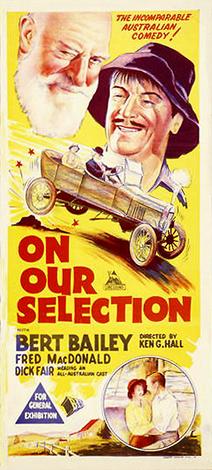
Kenneth George Hall was an Australian film producer and director, considered one of the most important figures in the history of the Australian film industry. He was the first Australian to win an Academy Award.

On Our Selection is a 1932 comedy based on the Dad and Dave stories by Steele Rudd. These had been turned into a popular play by Bert Bailey and Edmund Duggan in 1912, which formed the basis for the screenplay. Bailey repeats his stage role as Dad Rudd. He also wrote the script with director Ken G. Hall.
The Squatter's Daughter is a 1933 Australian melodrama directed by Ken G. Hall and starring Jocelyn Howarth. One of the most popular Australian films of the 1930s, it is based on a 1907 play by Bert Bailey and Edmund Duggan which had been previously adapted to the screen in 1910.

Albert Edward Bailey, better known as Bert Bailey, was a New Zealand-born Australian playwright, theatrical manager and stage and screen actor best known for playing Dad Rudd, in both mediums, the character from the books penned by Steele Rudd.

Our Friends, the Hayseeds is a 1917 Australian rural comedy from director Beaumont Smith. It centers on the rural family, the Hayseeds, and their rivalry with a neighbouring family, the Duggans.

Edmund Duggan was an Irish-born actor and playwright who worked in Australia. He is best known for writing a number of plays with Bert Bailey including The Squatter's Daughter (1907) and On Our Selection (1912). His solo career was less successful than Bailey's. His sister Eugenie was known as "The Queen of Melodrama" and married noted theatre producer William Anderson, for whom Duggan frequently worked as an actor, writer and stage manager.
On Our Selection is a 1912 Australian play by Bert Bailey and Edmund Duggan based on the stories with the same name by Steele Rudd. Bailey played Dad Rudd in the original production.
Fred MacDonald (1895–1968), was an Australian actor best known for playing Dave Rudd opposite Bert Bailey on stage and screen, starting with the original 1912 production of On Our Selection. He also played a similar role, Jim Hayseed, several times on screen for director Beaumont Smith.
The Squatter's Daughter is a 1910 Australian silent film based on the popular play by Bert Bailey and Edmund Duggan.
The Christian is a 1911 Australian silent film starring Roy Redgrave and Eugenie Duggan. It was the first film directed by Franklyn Barrett. The film was based on Hall Caine's play adapted from his novel The Christian which was published in 1897 and the first British novel to sell one million copies. It is considered a lost film.

A Girl of the Bush is a 1921 Australian silent film directed by Franklyn Barrett. It is one of the few films from Barrett to survive in its entirety today.
The Man from Outback is a 1909 Australian play by Bert Bailey and Edmund Duggan written under the name of 'Albert Edmunds'.

William Anderson was an Australian theatre entrepreneur.
My Mate, or a Bush Love Story is an Australian play by Edmund Duggan which was first produced in 1911.

Eugenie Marian Duggan was a popular Australian stage actress. She was the sister of the actors Edmund, P.J. and Kathleen Duggan. She began studying acting, won a number of elocution competitions and made her professional debut in 1890 in Romeo and Juliet.
The Squatter's Daughter may refer to:

The King's Theatre was a theatre in Melbourne, Australia, located at 133 Russell Street between Bourke Street and Little Collins Street.

Hilda Maggie Bridges was an Australian novelist, short story writer and music teacher.
Thunderbolt is a 1905 Australian play about the bushranger Captain Thunderbolt, based on the book Three Years with Thunderbolt by William Monckton.
The Bushwoman is a 1909 Australian play by Jo Smith. It was a popular early Australian play.











